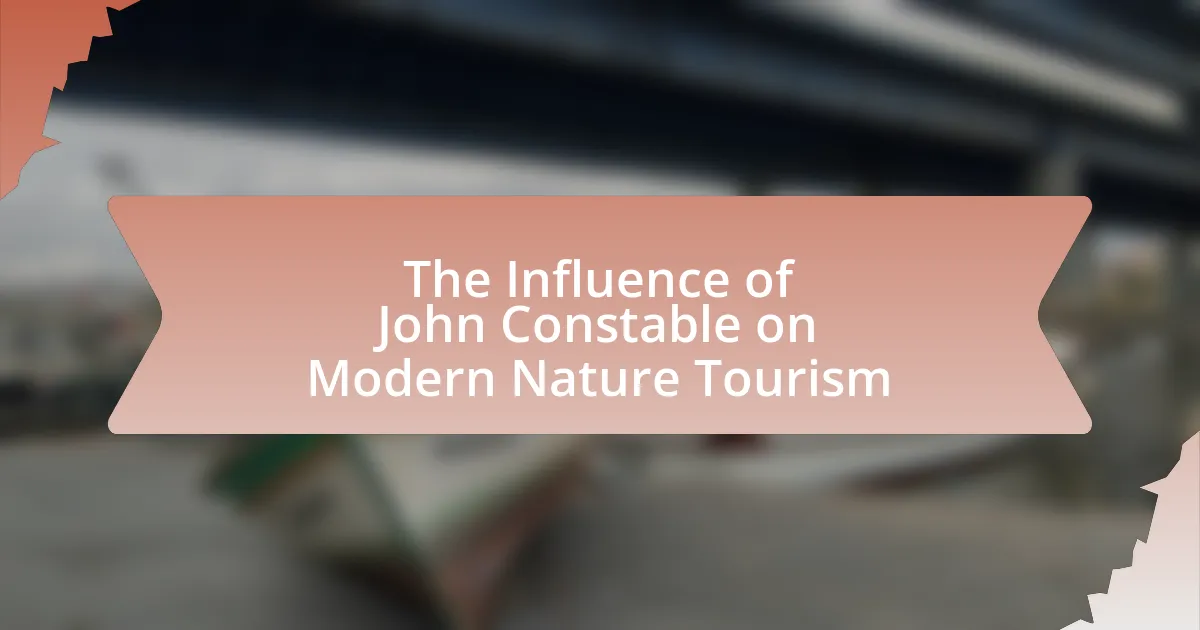John Constable, a pivotal figure in art history, significantly influenced modern nature tourism through his evocative depictions of the English countryside. His paintings, such as “The Hay Wain” and “Dedham Vale,” emphasized the beauty and emotional resonance of natural landscapes, fostering a greater appreciation for rural environments. Constable’s innovative techniques, including plein air painting and a focus on natural light, not only shaped perceptions of nature but also laid the groundwork for the Romantic movement, which ultimately contributed to the rise of nature tourism in the 19th century. His legacy continues to impact contemporary tourism practices, encouraging eco-tourism and art-inspired travel that connect visitors with the landscapes he immortalized.

What is the Influence of John Constable on Modern Nature Tourism?
John Constable significantly influenced modern nature tourism by popularizing the depiction of natural landscapes, which inspired a greater appreciation for rural environments. His paintings, particularly “The Hay Wain” and “Dedham Vale,” showcased the beauty of the English countryside, encouraging viewers to explore and experience these landscapes firsthand. This artistic representation of nature contributed to the Romantic movement, which emphasized emotional connections to the natural world, ultimately leading to the rise of nature tourism in the 19th century. The establishment of scenic routes and parks, influenced by Constable’s work, further facilitated access to natural beauty, making it a key aspect of leisure travel today.
How did John Constable’s art shape perceptions of nature?
John Constable’s art significantly shaped perceptions of nature by emphasizing the beauty and emotional resonance of the English landscape. His paintings, particularly “The Hay Wain” and “Dedham Vale,” showcased natural scenes with a focus on light, atmosphere, and the changing seasons, which encouraged viewers to appreciate the subtleties of their surroundings. Constable’s innovative use of color and texture, along with his dedication to plein air painting, allowed him to capture the essence of nature in a way that was both realistic and evocative. This approach not only influenced contemporary artists but also laid the groundwork for the Romantic movement, which celebrated nature as a source of inspiration and reflection. His work ultimately contributed to a growing awareness and appreciation of the natural world, influencing modern nature tourism by fostering a desire to experience and connect with the landscapes he depicted.
What themes in Constable’s work resonate with modern nature tourism?
John Constable’s work resonates with modern nature tourism through themes of pastoral beauty, emotional connection to landscapes, and the celebration of natural light. His depictions of the English countryside, particularly in paintings like “The Hay Wain,” emphasize the serene and idyllic aspects of rural life, which attract contemporary tourists seeking authentic nature experiences. Additionally, Constable’s focus on capturing the changing effects of light and weather in his landscapes reflects a deep appreciation for the natural environment, aligning with the values of eco-tourism that prioritize sustainability and the enjoyment of nature. This connection is further supported by the ongoing popularity of locations he painted, such as Dedham Vale, which remains a destination for nature enthusiasts and tourists today.
How did Constable’s techniques influence landscape representation?
John Constable’s techniques significantly influenced landscape representation by emphasizing the importance of capturing natural light and atmospheric effects. His use of plein air painting allowed him to depict landscapes with a sense of immediacy and realism, showcasing the changing conditions of the sky and weather. This approach encouraged subsequent artists to focus on the emotional and sensory experiences of nature rather than idealized or romanticized versions. Constable’s innovative brushwork and color palette also inspired the Impressionists, who adopted similar methods to convey movement and light in their landscapes. His work laid the groundwork for modern landscape painting, shifting the focus towards personal interpretation and the subjective experience of nature.
Why is John Constable considered a pivotal figure in art history?
John Constable is considered a pivotal figure in art history due to his innovative approach to landscape painting, which emphasized the emotional connection between nature and the viewer. His works, such as “The Hay Wain” and “Dedham Vale,” showcased a realistic portrayal of the English countryside, utilizing techniques like plein air painting to capture the effects of light and atmosphere. This focus on naturalism and personal expression influenced subsequent generations of artists, particularly the Impressionists, who adopted similar methods to convey their perceptions of the environment. Constable’s legacy is evident in the way he transformed landscape art into a medium for exploring human emotion and experience, thereby shaping the trajectory of modern art and its relationship with nature.
What innovations did Constable introduce in landscape painting?
John Constable introduced several key innovations in landscape painting, notably his emphasis on capturing natural light and atmospheric effects. He utilized a technique called “plein air” painting, which involved working outdoors to depict the changing conditions of light and weather directly from nature. This approach allowed him to create more vibrant and realistic representations of landscapes, as seen in works like “The Hay Wain.” Additionally, Constable’s use of color and texture, particularly his application of thick paint (impasto), contributed to a sense of immediacy and depth in his landscapes. His focus on local scenes and personal connection to the English countryside also set a precedent for future landscape artists, influencing the Romantic movement and modern nature tourism.
How did Constable’s approach differ from his contemporaries?
John Constable’s approach differed from his contemporaries primarily through his emphasis on capturing the natural landscape with a focus on realism and emotional depth. While many artists of his time, such as J.M.W. Turner, leaned towards dramatic effects and idealized representations, Constable prioritized the accurate depiction of the English countryside, utilizing techniques like plein air painting to observe and record the changing light and atmosphere directly from nature. This commitment to authenticity is evidenced by his use of sketches and studies, which he often transformed into larger works, reflecting a deep connection to the environment that was less common among his peers.
What role does Constable’s legacy play in contemporary tourism practices?
Constable’s legacy significantly influences contemporary tourism practices by promoting the appreciation of natural landscapes through art. His iconic depictions of the English countryside, particularly in works like “The Hay Wain,” have inspired tourism to rural areas, encouraging visitors to explore locations that reflect the beauty captured in his paintings. This connection is evident in the rise of art-inspired travel, where tourists seek to experience the landscapes that influenced Constable, thus driving economic benefits to these regions. Additionally, exhibitions and art trails dedicated to Constable’s work attract art enthusiasts, further integrating his legacy into modern tourism strategies.
How do modern tourism campaigns utilize Constable’s imagery?
Modern tourism campaigns utilize Constable’s imagery by incorporating his iconic landscapes to evoke a sense of nostalgia and connection to nature. Campaigns often feature pastoral scenes reminiscent of Constable’s work, such as rolling hills, serene rivers, and vibrant skies, to attract visitors seeking authentic rural experiences. For instance, destinations in the English countryside leverage Constable’s depictions to highlight their scenic beauty, enhancing promotional materials with visuals that resonate with his artistic style. This approach not only appeals to tourists’ desire for picturesque settings but also reinforces the cultural heritage associated with Constable’s legacy, thereby increasing the attractiveness of these locations.
What impact does Constable’s work have on eco-tourism initiatives?
Constable’s work significantly influences eco-tourism initiatives by promoting an appreciation for natural landscapes and environmental conservation. His paintings, characterized by their vivid depictions of the English countryside, inspire eco-tourism by encouraging visitors to explore and engage with these natural settings. The aesthetic value of Constable’s art has led to increased interest in the locations he portrayed, such as Dedham Vale, which has been designated an Area of Outstanding Natural Beauty. This designation supports eco-tourism by attracting visitors who seek to experience the landscapes that inspired Constable, thereby fostering economic benefits for local communities while promoting sustainable practices.
How can we connect Constable’s influence to current trends in nature tourism?
John Constable’s influence can be connected to current trends in nature tourism through his emphasis on capturing the beauty of the English landscape, which has inspired contemporary appreciation for natural environments. His paintings, particularly those depicting rural scenes and atmospheric effects, have fostered a cultural value placed on nature that aligns with the growing trend of eco-tourism and immersive outdoor experiences. For instance, the rise in popularity of destinations like the Lake District, which Constable famously depicted, reflects a modern desire to engage with and experience the landscapes that artists like him celebrated. This connection is further evidenced by the increase in nature-based travel, with statistics showing that eco-tourism has grown significantly, with a reported market size of over $300 billion globally, indicating a strong public interest in the natural world that resonates with Constable’s artistic legacy.
What are the implications of Constable’s influence on nature tourism experiences?
John Constable’s influence on nature tourism experiences significantly enhances the appreciation of natural landscapes. His detailed and emotive depictions of the English countryside, particularly in works like “The Hay Wain,” have shaped tourists’ expectations and experiences by promoting a deeper connection to nature. This connection is evidenced by the rise in popularity of locations he painted, such as Dedham Vale, which has become a sought-after destination for nature tourism. The aesthetic values he emphasized, such as light, atmosphere, and the beauty of rural life, continue to inspire contemporary tourism practices, encouraging visitors to seek authentic and immersive experiences in nature.
What practical lessons can modern nature tourism learn from John Constable?
Modern nature tourism can learn the importance of capturing the essence of landscapes from John Constable. His dedication to portraying the natural beauty of the English countryside through detailed observation and emotional engagement encourages contemporary tourism to focus on authentic experiences that resonate with visitors. Constable’s technique of using light and color to evoke mood can inspire tourism operators to create immersive environments that enhance visitors’ connections to nature. By emphasizing local landscapes and cultural narratives, modern nature tourism can foster a deeper appreciation for the environment, similar to how Constable’s paintings invite viewers to explore and cherish the natural world.
How can tourism operators incorporate artistic elements inspired by Constable?
Tourism operators can incorporate artistic elements inspired by John Constable by integrating landscape painting themes into their marketing materials and tour experiences. For instance, they can design guided tours that highlight locations depicted in Constable’s works, such as the English countryside, and provide art-inspired activities like plein air painting sessions. Additionally, operators can collaborate with local artists to create exhibitions or workshops that reflect Constable’s techniques and subjects, enhancing the cultural experience for tourists. This approach not only enriches the visitor experience but also promotes appreciation for Constable’s influence on landscape art and nature tourism.
What strategies can enhance visitor engagement through Constable’s themes?
Utilizing John Constable’s themes can enhance visitor engagement through immersive experiences that connect audiences with nature. Strategies include organizing guided tours that highlight landscapes depicted in Constable’s works, thereby fostering a deeper appreciation for the natural beauty he captured. Additionally, interactive workshops that allow visitors to create their own art inspired by Constable’s techniques can further engage participants. Research indicates that experiential learning, such as hands-on activities, significantly increases visitor satisfaction and retention of information. By integrating these strategies, venues can effectively leverage Constable’s themes to create memorable and engaging experiences for visitors.


